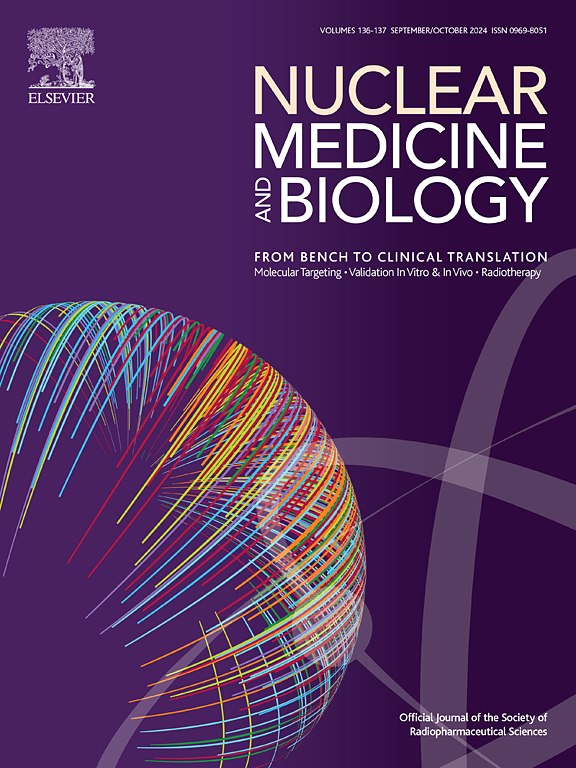Production and purification of radiolabeling-ready 132/135La from the irradiation of metallic natBa targets with low energy protons
IF 3.6
4区 医学
Q1 RADIOLOGY, NUCLEAR MEDICINE & MEDICAL IMAGING
引用次数: 0
Abstract
Introduction
Radiolanthanides 132La and 135La form a promising chemically matched theranostic pair. With a half-life of 18.95 h, 135La acts as the therapeutic isotope as it releases approximately 11 Auger electrons per decay, making it compatible with targeted Auger electron therapy (TAET), whereas 132La with half-life of 4.58 h undergoes positron emission making it compatible with imaging via positron emission tomography (PET).
Methods
132/135La were produced via irradiation of natural barium targets (99.9 %) with 12.8 MeV protons. A two-step separation scheme using extraction chromatographic resin TK200 (50–100 μm) and cation exchange resin Dowex 50Wx4 (200–400 mesh) was designed. Inductively coupled plasma mass spectrometry (ICP-MS) was used to quantify non-radioactive impurities in each fraction of the separation method. The distribution coefficients of La3+ in HNO3 on the TK200 resin and on both Dowex 50Wx8 (200–400 mesh) and Dowex 50Wx4 resins in ammonium α-hydroxyisobutyrate (pH 4.8) were determined, respectively.
Results
This novel separation scheme allowed for reliable separation of [132/135La]La3+ from the Ba2+ target material, resulting in a high radiochemical yield of 98.3 ± 2.1 % (n = 3) with the final elute being directly compatible with subsequent radiolabeling due to the use of ammonium α-hydroxyisobutyrate to eliminate steps in the radiopharmaceutical synthetic process.

低能质子辐照金属natBa靶制备和纯化可作放射性标记的132/135La
放射性镧系元素132La和135La形成了很有前途的化学配对治疗对。半衰期为18.95 h的135La作为治疗同位素,每次衰变释放约11个俄歇电子,使其与靶向俄歇电子治疗(TAET)兼容,而半衰期为4.58 h的132La经历正电子发射,使其与正电子发射断层扫描(PET)成像兼容。方法:用12.8 MeV质子辐照天然钡靶(99.9%)制备132/135La。采用萃取层析树脂TK200 (50-100 μm)和阳离子交换树脂Dowex 50Wx4(200-400目)设计了两步分离方案。采用电感耦合等离子体质谱法(ICP-MS)定量分离方法中各组分中的非放射性杂质。测定了HNO3中La3+在α-羟基异丁酸铵溶液(pH 4.8)中在TK200树脂、Dowex 50Wx8(200-400目)和Dowex 50Wx4树脂上的分布系数。结果:该分离方案可使[132/135La]La3+从Ba2+靶物质中可靠分离,放射化学产率高达98.3%±2.1% (n = 3),由于使用α-羟基异丁酸铵消除了放射性药物合成过程中的步骤,最终洗脱液与后续放射性标记直接兼容。
本文章由计算机程序翻译,如有差异,请以英文原文为准。
求助全文
约1分钟内获得全文
求助全文
来源期刊

Nuclear medicine and biology
医学-核医学
CiteScore
6.00
自引率
9.70%
发文量
479
审稿时长
51 days
期刊介绍:
Nuclear Medicine and Biology publishes original research addressing all aspects of radiopharmaceutical science: synthesis, in vitro and ex vivo studies, in vivo biodistribution by dissection or imaging, radiopharmacology, radiopharmacy, and translational clinical studies of new targeted radiotracers. The importance of the target to an unmet clinical need should be the first consideration. If the synthesis of a new radiopharmaceutical is submitted without in vitro or in vivo data, then the uniqueness of the chemistry must be emphasized.
These multidisciplinary studies should validate the mechanism of localization whether the probe is based on binding to a receptor, enzyme, tumor antigen, or another well-defined target. The studies should be aimed at evaluating how the chemical and radiopharmaceutical properties affect pharmacokinetics, pharmacodynamics, or therapeutic efficacy. Ideally, the study would address the sensitivity of the probe to changes in disease or treatment, although studies validating mechanism alone are acceptable. Radiopharmacy practice, addressing the issues of preparation, automation, quality control, dispensing, and regulations applicable to qualification and administration of radiopharmaceuticals to humans, is an important aspect of the developmental process, but only if the study has a significant impact on the field.
Contributions on the subject of therapeutic radiopharmaceuticals also are appropriate provided that the specificity of labeled compound localization and therapeutic effect have been addressed.
 求助内容:
求助内容: 应助结果提醒方式:
应助结果提醒方式:


